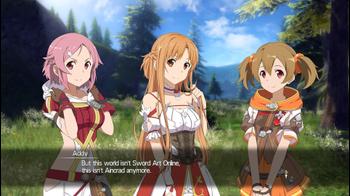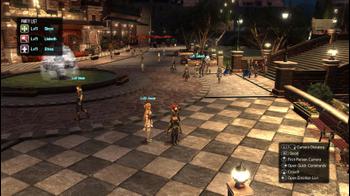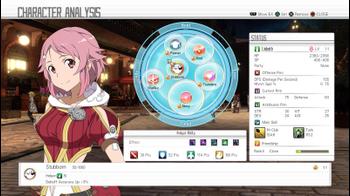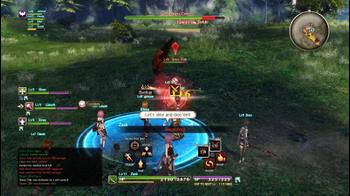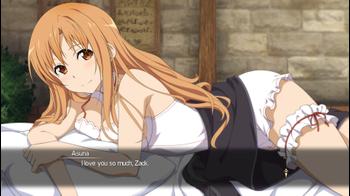
Sword Art Online: Hollow Realization Review
Let me say upfront that I am a big fan of Sword Art Online. While others may enjoy trashing the series for the directions it goes at times, I fell in love with the high stakes drama it presented for viewers. While .hack had some characters falling into comas if they encountered a certain person, Sword Art Online had thousands of people locked into an MMORPG, fighting for their very existence.
.hack//Sign came close with a main character who is unable to log off, but when people in SAO died in the game, they died in real life. To me, this is an amazing concept that had me hooked from the beginning. My love may have tapered off a little with Sword Art Online II, but I am always eager for something to renew my enjoyment.
But even though Sword Art Online takes place inside an MMORPG, this experience hasn't transitioned well to video games. Hollow Fragment had a huge translation problem, while Lost Song fell into a hole of mediocrity. Does Sword Art Online: Hollow Realization have what it takes to set it apart from its disappointing brethren? Yes and no.
The story takes place shortly after the events of Sword Art Online: Lost Song. All the important (living) characters from the anime, Hollow Fragment, and Lost Song making their return. A company quietly announces a spiritual successor to Sword Art Online called "Sword Art: Origin", a new game that allows players to port over most of their data from the original SAO to this new project. People around the world were upset they would dare evoke the name that took over 4,000 lives, but the protests slowly quelled over time until the present.
Kirito and his friends are invited to beta test this new game to help ease everyone's concerns, and shortly thereafter the game begins. The pacing can be all over the place - I quickly lost sight of the overarching narrative shortly into the game. This isn't too dissimilar from my experience with God Eater earlier this year, but at least that game touched on the issues more frequently.
Very early on, I ran right into one of my biggest issues. In other Sword Art Online games, you could only play as Kirito, the main protagonist of the series. Hollow Realization introduces a character customization mechanic where you're able to change the gender, hair, face, eyes, shape, and even the voice of the person you control.
And then I quickly realized the game provides absolutely no story context for this feature. Oh, I still got to see the custom avatar I created, but I may as well be playing Kirito because I have to listen to his voice during cutscenes. This also happens during moments where the camera is focused on my player, their mouth lip-syncing to Kirito's voice. It's more than a little jarring hearing my female character change from a male's voice to a noble lady going desu wa in combat. Sure, I can turn off Kirito's voice off in the game options, but that only makes it a little less awkward.
Not only that, but the rest of the group treats your character as if he's Kirito regardless of your name and appearance. Everything is told from his perspective, down to the flashbacks of prior events in the canon. It reminded me of White Knight Chronicles where I was almost having an out-of-body experience, seeing my avatar run around when the actual main character is present.
It all feels so disjointed. It's as if the developers wanted to have Kirito as the main character when all of a sudden a higher up walked into the conference room in the 11th hour and told them to make sure they had a character creator. All I could do was deal with it and ignore the fact I made an avatar to begin with. Bottom line: Hollow Realization doesn't know what it wants to be, and that hurts the overall product.
The game is set around a single hub city. You'll spend a lot of the time here buying and selling equipment, crafting items, and checking the job boards for different tasks (most of which are bounties and fetch quests). There are only a few stores to visit, making the town feel a bit sparse. While there are plenty of NPCs to talk to, but most of it is generic dialog. A lot of time is also spent building relationships with characters.
Just like in the other Sword Art Online games, you're able to have private conversations with different party members. During these intimate moments when the character really tells you what's on their mind, you can react positively or negatively to what they are saying. The goal is to read the mood and behave according to the person's feelings, like whether you are in fact listening.
As these conversations develop, you can make a bold move to deepen the relationship. Timing is key here, and if you do things correctly, you'll be able to hold hands with the other person or even carry them like a princess. By maxing out their affection, you can have "pillow talk" with them in your bed which eventually leads to a special CG.
As silly as this sounds, it is an interesting mechanic - at first. But this quickly leads to quickly tapping through the text to get to the unlockable CG. I felt like a lot more work could have been put here during the localization to flesh out the conversations rather than the straight translations and broken dialog players will have to put up with (yes, there is still a decent amount of localization issues here as well). Many of the responses made absolutely no sense in the natural flow of discussion.
Each party member has a Character Analysis menu that can be pulled up when you approach them. This allows you to check out their current stats and skills. The most important feature here is the Affection System, which measures their emotions towards the player.
The Attitude Rating shown on this screen affects their fighting ability and their behavior when you meet them in town and through private messages. This can also unlock special abilities, so you have to keep your actions in check since they have a strong impact on the development of each party member.
The action can take getting used to, especially with how busy the UI is on the screen. You have the party's health bars, the mini map, the shortcut buttons, the battle log (that only keeps track of actions, not dialogue), and your own stats at the bottom of the screen. And when characters are setting up a chain skill, their pictures cover up parts of the screen, including the mini map which can sometimes be a little annoying. The interface closely resembles the one from Final Fantasy XIV - it's practically a carbon copy. May as well take after the best, right?
The tutorial system also leaves a lot to be desired. Instead of trying to contextualize it in the game itself while giving certain prompts for those like me who may forget how to manage the more complicated maneuvers, it makes you sit through the slow slideshow presentation as it was originally presented.
Each party member has a set of skills they prefer to use that ties into their class. This can be affected by your use of Compliments during battle, which they'll lean more heavily towards. If you don't want that character to continue focusing on a certain skill, you can lock it to prevent further development. This allows players to develop their party members exactly the way they want them to, and can play a key role in late game content. I found myself using this as I tried to hone in on the people I wanted to have in my party at the majority of the time, which was mostly tank characters.
And here we run into another big problem with the game: the party AI can be all over the place. At times they work well together, pulling off chains and combination attacks without much input from me. More often than that, they'll wind up running into objects in the environment and getting themselves killed by monsters without putting up a fight.
You do have control over their behavior using a set of shortcuts that are mapped to the D-Pad and face buttons and activated when holding down the L button. This will let you tell the party to concentrate their attacks on a certain enemy, focus on healing, play defensively, and more. The worst part is when I ask the party to focus on healing, I never get healed. Instead, they heal themselves and leave me to fend for myself. I don't get it.
This also happens when I tell them to Dodge; my party only dashes back once while staying in the path of an enemy's area of attack skill. Sometimes they just stand there and do almost nothing while I attack a mob by myself. It can get bad, and only gets worse when you die as you lose all party control. This is especially aggravating since dying will dump you back into town, forcing you to run all the way back to where you originally were.
You can also Compliment a party member after they perform a certain skill that allows them to remember certain actions, and over time that action will become their specialty. This is the only way you can influence their progression, and after playing for dozens of hours, I'm still unsure if what I'm doing is having any effect. Like .hack, the only way you can change your party's equipment is by gifting them the items, something I didn't discover until much later. It's not immediately obvious if they equip the things you give them, either.
That isn't to say the combat is necessarily challenging. Other than the different Notorious Monsters and boss characters you face during the game, there was plenty of mashing going on as I tried to figure out the various skill chains. While it was repetitious at times, it didn't bother me as I was actually having loads of fun with the action - unpredictable party AI aside. I just wish I didn't have to constantly use the commands to get my party to do anything.
I will say Hollow Realization really tapped into my addiction of finding great loot for my character. When I discovered a very powerful katana early on, I was able to forgive many of the shortcomings I had with the game. That's how great it was having a weapon that allowed me to mow down mobs of enemies with little effort. There's also a ton of armor and accessories to find that alters the appearance of your character as they travel around the map - one of my absolute favorite things in RPGs. And thanks to having ten different weapon styles to choose from that all level up with use, I had fun playing around with all the tools.
I loved how you'll be able to meet other computer-controlled parties running around the fields who are also trying to level up their own characters. It provides a nice sense of immersion into the world the game is trying to create. You can also set up alliances with other roaming parties by simply fighting the same monster they currently are involved with.
At the lower levels this is hardly useful as the other parties tend to run away shortly after you try and help them, but this does make for exciting combat towards the later parts of the story. It definitely gives it a far more realistic portrayal of a popular MMO when you see "live players" running about.
There is a wealth of content to partake in Hollow Realization. It has a lengthy campaign mode, hundreds of optional side quests, and online cooperative play with up to 7 other players. There are also Event Fragments - instanced events located around each map that can net materials and treasure chests. Each Event Fragment has a list of objectives like defeating the enemies roaming around a given area.
By completing an Event Fragment, the next part of that quest will begin that may hold very powerful monsters that can grant rate items. This helps to fill in some of the empty areas of the maps, which isn't a whole lot since there are several packs of monsters to deal with.
There's also a handy fast travel system. Once you unlock a teleportation stone in one of the areas, you'll be able to head straight back to that area while outside battle by pulling up the map on the in-game menu. It's a lovely feature that saved me a lot of time during quests. The only problem here is when you're at the south tip of a large map and have to run to the opposite side for a quest.
Visually, the game is above average compared to other games of this type with a high degree of fidelity. While most of the areas are your typical fantasy fare with open fields, dark caverns, and rocky areas, they each look well crafted. The high-resolution 2D portraits during key moments are particularly impressive and make you really feel like you're in the anime. It may look and feel like a budget title, but it's entirely superior to Lost Song in every facet.
Enemy variety is exceptional. Sure, you'll run into many of the same monsters during the adventure, but the game does slowly introduce different types as you enter different maps. Even the palette swapped monsters are cosmetically altered to avoid criticism. Everything runs at a smooth framerate with almost no indication of slowdown to speak of. And while the Japanese voice acting is top notch (and most of the dialog is voiced), the soundtrack is largely forgettable and fades into the background with little presence.
Sword Art Online: Hollow Realization is easily the best SAO game made by far. Not only is there plenty of things to do, but the combat, gameplay mechanics, and production is far better than the prior entries. It is clear a lot of work went into making this game, and they continue to add content with nearly every patch they've released so far. Unfortunately, it's weighed down by a low-stakes plot; awful party intelligence; and one too many systems at play. They've an ample amount of potential here, but unless you're a fan of the series or at least have a passing interest, it's difficult to recommend.
